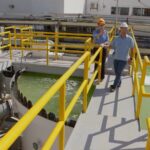New study and interactive map point to environmental justice disparities (and solutions) in land conservation

Newswise — A new study in Environmental Research Letters shows striking disparities in the distribution of conserved land across multiple dimensions of social marginalization in New England – and creates a tool to help address them.
In a New England-wide analysis, the researchers found that communities in the lowest income quartile, and communities with the highest proportions of people of color have access to only about half as much protected land near where they live. These disparities persist across urban, suburban, and rural communities, and across decades.
“This is consistent with the very long history of exclusion and marginalization in conservation efforts,” says Boston-based social justice scholar Neenah Estrella-Luna, a co-author on the study. “We know that protected open space provides positive opportunities for recreation, social activities, mental and physical health, interactions with nature, food production, and resilience to heat waves. Disparities in access to these benefits that are patterned on race or other characteristics of marginalization require redress. This is a moral imperative.”
But the team, which also included Harvard Forest researchers Lucy Lee and Jonathan Thompson, and Katharine Sims and Margot Lurie (’21) of Amherst College – didn’t stop at identifying the problems. They also created tools that can inform community-led efforts to solve them.
The researchers analyzed lands that rank highly with conventional conservation criteria – such as wildlife habitat, drinking water, and carbon sequestration – and mapped their relationship with lands that rank highly for human environmental justice criteria – including communities with low income, high percentages of people of color, and high percentages of English language learners. They found that the two sometimes don’t overlap, and that future land protection that follows the same patterns as in the past could further deepen environmental justice disparities.
“There are many reasons for protecting land,” explains Lucy Lee, co-author and Harvard Forest Research Assistant. “By analyzing how conservation has played out with specific underlying motivations, we could compare how prioritizing land in different ways would align, or not align, with environmental justice.”
The team created a new prioritization system to help communities, state agencies, and conservation organizations identify specific opportunities for future conservation based on environmental justice criteria. They also built a free, online mapping tool to highlight these opportunities on the landscape.
“Until now, there hasn’t been an explicit way to show how protected areas across the region are distributed in relationship to environmental justice focus areas,” explains co-author Jonathan Thompson, a Senior Ecologist at Harvard Forest. “Several regional conservation groups have already reached out to us, saying they’d like to use this tool as part of their conservation prioritization process.”
The research team emphasizes that this tool is meant to inform and support locally led efforts that center marginalized communities and their self-determined goals.
Estrella-Luna explains, “It’s really important to remember that conservation as we know it began with the explicit idea that the natural environment is only ‘good’ if it is devoid of humans, particularly Indigenous people, other people of color, and poor people. The only way to repair centuries of exclusion, neglect, and marginalization is to make justice and equity central goals of resilience planning.”
Margot Lurie, whose academic internship work at Amherst College helped to catalyze the research, also emphasized the importance of processes for community engagement and consent: “We hope that this tool can both empower local communities interested in protecting nearby land and offer guidance to conservation organizations regarding who needs to be at the table in land-use planning decisions.”
The study highlighted the multiple environmental burdens faced by marginalized communities. Ninety-six percent of the areas identified in the study as environmental justice focus areas contained at least one EPA-listed brownfield site—land where pollutants and contaminants complicate redevelopment.
Despite that, the team points to the importance of restoring existing developed land, including improving forest canopy in marginalized communities, and building new partnerships that can increase access to existing open space.
Lead author Katharine Sims, Professor of Economics and Environmental Studies at Amherst College, notes that there are many ways to improve access that go beyond new land conservation, including better transportation to existing areas, park entry points that are walkable and connected to communities, and stronger support for urban food production spaces. “Conservation organizations are also increasingly understanding that even when greenspace has been available, access has been limited for many by personal experiences of racism or exclusion,” Sims points out. “Changes in leadership structure, outreach, and programming can increase access by making open spaces truly welcoming to all.”
- Supreme Court’s EPA Ruling Puts Human Health and Ecology at Risk
 The Supreme Court has curtailed the ability of the Environmental Protection Agency to reduce carbon emissions from power plants in a decision that could limit other federal agencies’ regulatory powers. Catherine Kling is an environmental economist and an expert in water quality modeling who served for 10 years on the EPA’s Science Advisory Board. Kling says… Read more: Supreme Court’s EPA Ruling Puts Human Health and Ecology at Risk
The Supreme Court has curtailed the ability of the Environmental Protection Agency to reduce carbon emissions from power plants in a decision that could limit other federal agencies’ regulatory powers. Catherine Kling is an environmental economist and an expert in water quality modeling who served for 10 years on the EPA’s Science Advisory Board. Kling says… Read more: Supreme Court’s EPA Ruling Puts Human Health and Ecology at Risk - Come Clean for Earth During the Great American Campout
 Clean Earth Challenge Offers Way to Restore Land, Oceans, Waterways While Enjoying the Great Outdoors RESTON, Va. /PRNewswire/ — To inspire Americans to camp green and come clean for Earth, the National Wildlife Federation is partnering with Johnson Outdoors to launch this year’s Great American Campout. The Great American Campout encourages people to get outdoors and connect with nature… Read more: Come Clean for Earth During the Great American Campout
Clean Earth Challenge Offers Way to Restore Land, Oceans, Waterways While Enjoying the Great Outdoors RESTON, Va. /PRNewswire/ — To inspire Americans to camp green and come clean for Earth, the National Wildlife Federation is partnering with Johnson Outdoors to launch this year’s Great American Campout. The Great American Campout encourages people to get outdoors and connect with nature… Read more: Come Clean for Earth During the Great American Campout - Scientists Fail to Locate Once-Common CA Bumble Bees
 Climate change, urbanization and pesticides imperil wild pollinators Newswise — Several species of California bumble bees have gone missing in the first statewide census of the fuzzy pollinators in 40 years. If they can be found, a recent court ruling could help save them. Smaller-scale studies have documented significant declines in bumble bee populations around… Read more: Scientists Fail to Locate Once-Common CA Bumble Bees
Climate change, urbanization and pesticides imperil wild pollinators Newswise — Several species of California bumble bees have gone missing in the first statewide census of the fuzzy pollinators in 40 years. If they can be found, a recent court ruling could help save them. Smaller-scale studies have documented significant declines in bumble bee populations around… Read more: Scientists Fail to Locate Once-Common CA Bumble Bees - WATER: We Have Too Much, But Not Enough – To Air On The Science Channel And MotorTrend TV
 NEW YORK (June 15, 2022) – Water – it’s one of the greatest challenges all nations face today. Though it covers about 71% of the earth’s surface, more than 97% is found in the ocean, unusable for drinking, growing crops and most industrial uses. In fact, less than 3% of the world’s water is fresh, and, of… Read more: WATER: We Have Too Much, But Not Enough – To Air On The Science Channel And MotorTrend TV
NEW YORK (June 15, 2022) – Water – it’s one of the greatest challenges all nations face today. Though it covers about 71% of the earth’s surface, more than 97% is found in the ocean, unusable for drinking, growing crops and most industrial uses. In fact, less than 3% of the world’s water is fresh, and, of… Read more: WATER: We Have Too Much, But Not Enough – To Air On The Science Channel And MotorTrend TV - On the 30th Anniversary of World Oceans Day, SeaWorld Announces Commitment to Support UN Sustainable Development Goal 14 ‘Life Below Water’ with Nearly 60 Years of Taking Action to Protect Marine Animals and their Habitats
 SeaWorld will continue to act on UN SDG 14 to conserve and sustainably use the ocean, seas, and marine resources SeaWorld has developed and supported various aquaculture programs that reintroduce healthy and abundant fish populations necessary to sustain sea life Restoring coral reef systems has been and remains a priority for SeaWorld in Florida and worldwide SeaWorld will maintain… Read more: On the 30th Anniversary of World Oceans Day, SeaWorld Announces Commitment to Support UN Sustainable Development Goal 14 ‘Life Below Water’ with Nearly 60 Years of Taking Action to Protect Marine Animals and their Habitats
SeaWorld will continue to act on UN SDG 14 to conserve and sustainably use the ocean, seas, and marine resources SeaWorld has developed and supported various aquaculture programs that reintroduce healthy and abundant fish populations necessary to sustain sea life Restoring coral reef systems has been and remains a priority for SeaWorld in Florida and worldwide SeaWorld will maintain… Read more: On the 30th Anniversary of World Oceans Day, SeaWorld Announces Commitment to Support UN Sustainable Development Goal 14 ‘Life Below Water’ with Nearly 60 Years of Taking Action to Protect Marine Animals and their Habitats







